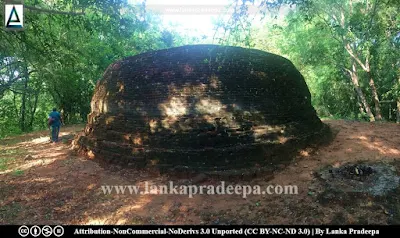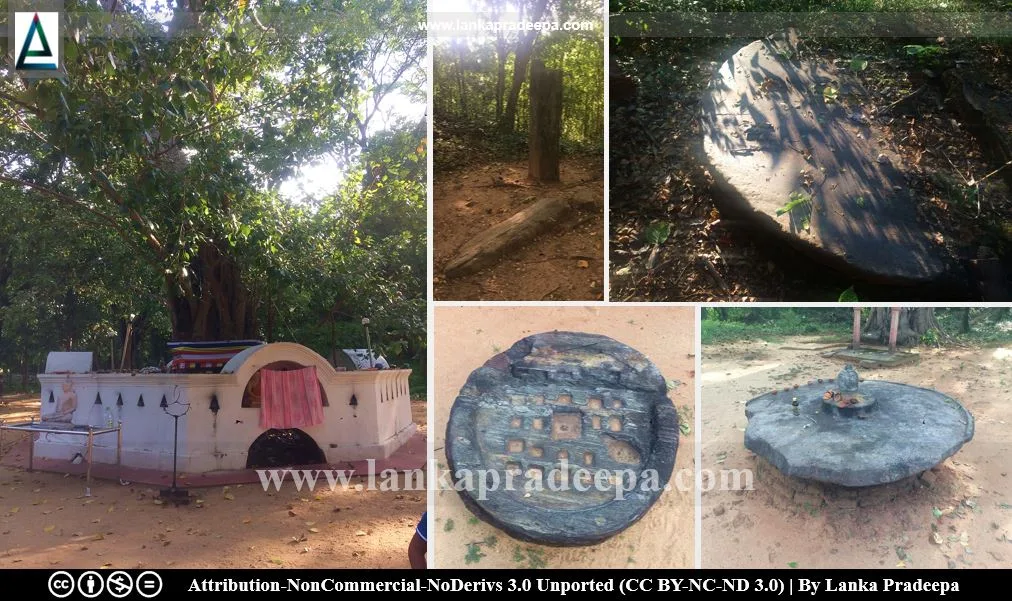
|
This Stupa is believed to have been built by Dutugemunu |
Nagadeepa Raja Maha Viharaya (Sinhala: රිදීමාලියද්ද නාගදීප විහාරය, මහියංගනය) is a Buddhist temple situated in Uraniya village in Rideemaliyadda, Badulla District, Sri Lanka.
History
Folklore
According to local tradition, the history of Nagadeepa Viharaya goes far back as the history of nearby Mahiyangana Viharaya. Some believe that this temple was built during the reigns of King Kavantissa (205-161 B.C.) and King Dutugemunu [(161-137 B.C.) Priyadarshani & Gunasena, 2017]. It is also said that Prince Dutugemunu and his army who were advancing to Mahiyanganaya from Mahagama (present Tissamaharama) in the second century B.C. had passed a place named Tungam Kasatapitiya, a place probably located near Uraniya (Nicholas, 1963).
The name: Nagadeepa
Two anecdotes are there that describe how the present name "Nagadeepa" originated (Priyadarshani & Gunasena, 2017). According to one anecdote, the name has come into parlance as a Buddhist monk who arrived from Nagadeepa (present Jaffna Peninsula) had lived in this area. The other anecdote says that the name has come to usage as it is related to the Buddha's second visit to Sri Lanka (Priyadarshani & Gunasena, 2017). According to Sri Lankan chronicles such as Mahavamsa, the Buddha in the fifth year after his enlightenment visited Nagadeepa in Sri Lanka to settle a dispute that arose between two royal kinsmen of the Naga clan Chulodara and Mahodara (nephew and uncle). As the present temple site is located very near Mahiyanganaya (the place to where the Buddha's first arrival happened), locals have tended to believe that this temple is the original Nagadeepa that is mentioned in the chronicles. However, extensive archaeological investigations conducted by scholars have identified the present Jaffna Peninsula as the ancient Nagadeepa (Pieris, 1917; Pieris, 1919).
Inscriptions
A few slab and pillar inscriptions belonging to the 6-7th, 9-10th, and 17th centuries A.D. have been discovered from the site. Of them, the slab inscription with the characters of the 6-7th centuries A.D. is almost worn. The inscription of 9-10th centuries A.D. is found engraved on a stone pillar which is now broken into two pieces.
Period: 9th-10th centuries A.D
Script: Medieval Sinhala
Language: Medieval Sinhala
Content: This is a Samvata pahan or an edictal pillar put up by the king's officials, having come to an agreement to bestow some privileges to a monastery.
Reference: The information board at the site by the Department of Archaeology and the Ministry of National Heritage.
The 17th-century inscription records; "Nagadeepeta Pooja vu pradeepe 1691" (the lamp donated to Nagadeepa 1691). This inscription confirms that this place is known as Nagadeepa since the 17th century.
The Temple
The temple is situated adjoining the Nagadeepa Maha Wewa reservoir that was built by damming the Heppola Oya under an irrigation scheme set up in 1969. With this irrigation scheme, some of the unexplored ruins around the temple premises are said to have gone under the water of the reservoir. During the Mahiyangana Gam Udawa program in 1989, some restoration works were carried out for the development of the temple. On 11 August 2008, the then Sri Lankan President Mahinda Rajapaksa visited this temple and participated in some religious activities.
A large number of ruins including two Stupas, the ruins of an ancient image house, and a building with stone pillars which is believed to be a Devalaya are found within the temple premises (Priyadarshani & Gunasena, 2017). As evident by this large number of ancient ruins, it is assumed that this temple may have existed as a Vihara complex in the past (Priyadarshani & Gunasena, 2017).
Stupas

There are two ancient Stupas at the site. Of them, the oldest Stupa which is known as the Kanchuka Stupa is located at the top of a small hillock like a massive overgrown mound of earth. According to the view of some, that mound of earth, in ancient times, was also a massive Stupa built by constructing a bricklayer over it. Locals believe that this Stupa was built by King Kavantissa (205-161 B.C.).
The other Stupa of the temple is located at a lower ground than the largest one and is believed to have been built by King Dutugemunu (161-137 B.C.).
Ancient Image House
The ancient image house is located near the small Stupa and it presently lays under the foundation of a modern building which was used as the monks' dwelling until the recent past. The dilapidated foundation of the ancient image house and a plain Sandakada Pahana (a moonstone) belonging to the early Anuradhapura Period are still visible beneath the foundation of the modern building. However, the government authorities have taken the necessary measures to demolish that modern building and unearth the ruins of the ancient image house.
The Bodhi Tree
The Bodhi tree in Uraniya Nagadeepa Viharaya is said to be one of the 32 saplings of Jaya Sri Maha Bodhiya in Anuradhapura. Locals strictly believe that by doing suitable religious rituals for this Bodhi tree they can fulfil their future hopes and expectations.
A Protected Site
The ancient Nagadipa Raja Maha Vihara in Uraniya Village in Divisional Secretary’s Division of Ridimaliyadda is an archaeological protected monument, declared by a government gazette notification published on 19 November 1960.


Related Posts
Read Also
References
Books, Government Gazette Notifications, Journal Articles
1) Nicholas, C. W., 1963. Historical topography of ancient and medieval Ceylon. Journal of the Ceylon Branch of the Royal Asiatic Society, New Series (Vol VI). Special Number: Colombo. Royal Asiatic Society (Ceylon
Branch). p.50.
2) Pieris, P.E., 1917. Nagadipa and Buddhist remains in Jaffna. The Journal of the Ceylon Branch of the Royal Asiatic Society, (Vol. 26).
pp.11-30.
3) Pieris, P.E., 1919. Nagadipa and Buddhist remains in Jaffna: Part II. The Journal of the Ceylon Branch of the Royal Asiatic Society, (Vol.
28). pp.40-67.
4) Priyadarshani, S.A.N.; Gunasena, I.P.P., 2017. Pauranika Sthana Ha Smaraka: Badulla Distrikkaya (In Sinhala). Department of Archaeology. ISBN: 955-9159-48-8. pp.20-22.
5) The Gazette of the Democratic Socialist Republic of Sri Lanka. No: 12230. 19 November 1960.
Location Map
Dynamic Google Map
මහියංගනය නාගදීප විහාරය
නාගදීප විහාරය ශ්රී ලංකාවේ බදුල්ල දිස්ත්රික්කයේ ඌරණිය ගම්මානයෙහි පිහිටි බෞද්ධ සිද්ධස්ථානයකි.
ජනප්රවාද
ප්රාදේශිය විශ්වාසයන්ට අනූව, නාගදීප විහාරයේ ඉතිහාසය ඒ ආසන්නයේ පිහිටි මහියංගන විහාරයේ ඉතිහාසය තරම්ම ඈතට විහිදෙයි. මෙම විහාරය ඉදිකරන ලද්දේ කාවන්තිස්ස (ක්රි.පූ. 205-161) හා දුටුගැමුණු (ක්රි.පූ. 161-137) රාජ්ය සමයන්හි බව සමහරෙකුගේ විශ්වාසය වේ. ක්රි.පූ. 2වන සියවසේදී මහගම (වත්මන් තිස්සමහාරාම) සිට මහියංගන දක්වා පැමිණෙමින් සිටි දුටුගැමුණු කුමරු සහ ඔහුගේ හමුදාව, ඌරණිය ආසන්නයේ පිහිටියා යැයි සැලකෙන තුන්ගම් කසටපිටිය නම් ස්ථානය පසුකල බව කියැවෙයි.
නාගදීප නාම සම්භවය
වත්මන් "නාගදීපය" යන නාමය කෙසේ සම්භූත විණිදැයි විස්තර වන කතාන්දර ද්විත්වයක් වෙයි. ඉන් එක් කතාන්දරයකට අනූව, මෙම නාමය ව්යවහාරයට පැමිණ ඇත්තේ නාගදීපයේ (වත්මන් යාපනය අර්ධද්වීපය) සිට පැමිණි බෞද්ධ භික්ෂුවක් මෙම ප්රදේශයේ වාසය කිරීම හේතුවෙනි. අනෙක් කතාන්දරය පවසන්නේ මෙම නාමය භාවිතයට පැමිණ ඇත්තේ එය බුදුන් වහන්සේගේ දෙවන ලංකාගමනය සමග සම්බන්ධ වන නිසා බවයි. මහාවංසය වැනි ශ්රී ලාංකික වංසකථා ප්රකාරව, බුදුන්වහන්සේ සිය බුද්ධත්වයෙන් පස්වෙනි වසරේදී චූලෝදර හා මහෝදර (බෑණනුවන් සහ මාමා) යන නාග ගෝත්රික නායකයින් දෙදෙනා අතර ඇතිවූ ආරවුලක් සංසිදවීම පිණිස නාගදීපයට වැඩම කොට තිබේ. වත්මන් විහාර භූමිය මහියංගනයට (බුදුන් වහන්සේගේ ප්රථම ලංකාගමනය සිදුවූ ස්ථානය) ඉතා ආසන්නව පිහිටා තිබීම හේතුවෙන් ප්රාදේශීය වැසියන් මෙම විහාරය වංසකථාහී දැක්වෙන සැබෑම නාගදීපය යැයි විශ්වාස කිරීමට නැඹුරු වී තිබේ. කෙසේවෙතත්, සිදුකර ඇති පුළුල් පුරාවිද්යා විමර්ශන මගින් වත්මන් යාපනය අර්ධද්වීපය පුරාණ නාගදීපය වශයෙන් විද්යාර්ථීන් විසින් තහවුරු කොටගෙන ඇත.
සෙල්ලිපි
ක්රි.ව. 6-7,9-10, හා 17වන සියවස් වලට අයත් පුවරු ලිපි හා ටැම් ලිපි කිහිපයක් විහාර භූමියෙන් හමුවී තිබේ. මින් 6-7 සියවස් වලට අයත් අක්ශර සහිත පුවරු ලිපිය සම්පූර්ණයෙන්ම පාහේ ගෙවී ගොස් ඇත. ක්රි.ව. 9-10 සියවස් සමයට අයත් සෙල්ලිපිය ශිලා ස්ථම්භයක් මත කොටා තිබෙනු හමුවන අතර එයද අද වනවිට කොටස් දෙකකට කැඩී ගොස් ඇත.
ඌරණිය නාගදීප ටැම් ලිපිය
කාලය: ක්රි.ව. 9-10 සියවස්
අක්ෂර: මධ්යකාලීන සිංහල
භාෂාව: මධ්යකාලීන සිංහල
අන්තර්ගතය: ව්යවස්ථා ලේඛනයක් ඇතුලත් සම්වතා පහන් නමින් හඳුන්වන මෙම ටැම් ලිපියෙහි රාජ්ය නිලධාරීන් විසින් සම්මුතියකට පැමිණ විහාරස්ථානයකට ප්රධානය කරන ලද වරප්රසාද පිළිබඳව සඳහන් වේ.
මේ අතර 17වන සියවසට අයත් සෙල්ලිපියෙහි "නාගදීපෙට පූජා වූ ප්රදීපේ 1691" ලෙස වැකියක් කොටා ඇත. මින් 17වන සියවසේදී මෙම ස්ථානය නාගදීපය වශයෙන් හඳුන්වනු ලැබ ඇති බැව් සනාථ කරයි.
විහාරය
1969 වසරේ පිහිටුවනු ලැබූ වාරි සැළසුමකට අනූව හැප්පොල ඔය හරස් කිරීමෙන් ඉදිකල නාගදීප මහ වැව ආසන්නයේ විහාරය පිහිටා තිබේ. මෙම වාරි සැළස්ම ක්රියාත්මක කිරීමත් සමග විහාර පරිශ්රය අවට ගවේෂණය නොකෙරූ සමහර නටඹුන් ජලාශයට යටවූ බව පැවසෙයි. 1989 වර්ෂයේ ක්රියාත්මක වූ ගම් උදාව වැඩසටහන යටතේ විහාරයේ දියුණුව උදෙසා යම් සංවර්ධන කටයුතු ක්රියාවට නංවනු ලැබුණි. 2008 අගෝස්තු 11වන දින එවක ජනාධිපති වූ මහින්ද රාජපක්ෂ මහතා මෙම විහාරයේ යම් ආගමික කටයුත්තකට සහභාගී විය.
ස්තූප ද්විත්වයක්, නටඹුන් වූ පුරාණ පිළිම ගෙයක්, හා දේවාලයකට අයත් යැයි විශ්වාස කෙරෙන ගල්කණු සහිත ඉදිකිරීමක් ඇතුළු නටඹුන් රැසක් විහාර පරිශ්රයෙන් හමුවේ. මෙලෙස පුරාණ නටඹුන් විශාල ප්රමාණයකින් සාකෂ්ය වන පරිදි, මෙම විහාරය අතීතයේදී විහාර සංකීර්ණයක් ලෙස පවතින්නට ඇතැයි උපකල්පනය කෙරේ.
ස්තූප
පුරාණ ස්තූප ද්විත්වයක් මෙම පරිශ්රයෙහි පිහිටයි. ඒ අතුරින් පැරණිතම ස්තූපය ලෙස සැළකෙන කංචුක ස්තූපය වල් වැදීගිය විසල් පස් ගොඩැල්ලක් ලෙස දිස්වන කුඩා කඳු ගැටයක් මත පිහිටයි. සමහරෙකුගේ දැක්ම අනූව, අතීතයේදී මෙම පස් ගොඩැල්ල ඒ වටා ගඩොල් තට්ටුවක් යෙදීමෙන් ඉදිකරනු ලැබූ විශාල ස්තූපයක් වේ. ප්රාදේශීයයන් විශ්වාස කරන්නේ මෙම ස්තූපය කාවන්තිස්ස රජු විසින් ඉදිකරන්නට ඇති බවයි.
අනෙක් ස්තූපය කංචුක ස්තූපයට පහළන් වූ මළුවක පිහිටයි. එය දුටුගැමුණු රජු විසින් ඉදිකරන ලද්දක් ලෙස විශ්වාස කෙරේ.
පුරාණ පිළිම ගෙය
භික්ෂු ආවාස ගෙය ලෙස මෑතක් වනතුරු භාවිත කල ගොඩනැගිල්ලේ පාදමට යටවී මෙම පුරාණ පිළිම ගෙය පවතියි. අනුරාධපුර යුගයේ මුල් සමයට අයත් යැයි සැළකෙන සඳකඩ පහනක් හා පුරාණ පිළිම ගෙයි දිරාපත් වූ පාදම් කොටස් තවමත් මෙම නූතන ගොඩනැගිල්ලෙහි පාදමට යටින් දැකගත හැකිවේ. කෙසේනමුදු, බලධාරීන් විසින් මෙම නූතන ගොඩනැගිල්ල කඩාදමා පුරාණ ඉදිකිරීමෙහි නටඹුන් මතුකර ගැනීමට අදාල ක්රියාමාර්ග ගෙන ඇත.
බෝධිය
අනුරාධපුර ජය ශ්රී මහා බෝධියෙහි දෙතිස් අංකුරයන්ගෙන් එකක් ලෙස ඌරණිය නාගදීප විහාරයෙහි පිහිටි බෝධිය සැළකෙයි. මෙම බෝධියට සුදුසු වන්දනාමාන සිදුකිරීමෙන් සිය අනාගත බලාපොරොත්තු හා ප්රාර්ථනා සඵල වන බවට ප්රාදේශීයයන් අතර දැඩි විශ්වාසයක් පවතී.
පුරාවිද්යා ස්මාරක ස්ථානය
රිදීමාලියද්ද ප්රාදේශීය ලේකම් කොට්ඨාශයට අයත් ඌරණිය ගම්මානයෙහි පිහිටි නාගදීප රජ මහා විහාරය, 2016 නොවැම්බර් 19 දින ප්රකාශයට පත් රජයේ ගැසට් නිවේදනය මගින් ආරක්ෂිත පුරාවිද්යා ස්මාරකයක් ලෙස නම් කොට ඇත.


